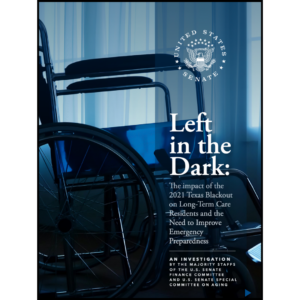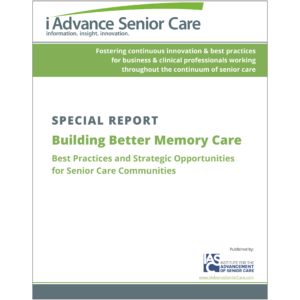Safety: A Key Ingredient in the Recipe for Success
| Safety: A Key Ingredient in the Recipe for Success |
| From CNAs to administrators, everyone at The Forest at Duke makes safety a priority BY JAMES J. THOMPSON, MHA |
| As all good managers understand, the key to any successful enterprise is a well-trained and dedicated workforce. It doesn’t occur by accident. As employers, we need to demonstrate our sincere concern for all our employees. Perhaps one of the most dramatic demonstrations of such caring is in the area of safety, which (as has been said) is everyone’s business-from the CEO to the newest CNA. |
| The significance of a sound safety program is far-reaching. With such a program in place, employees will not only feel that their employers care about their well-being, but they also will recognize that each of them has an important role in the overall mission of the facility. If, for example, one team member is absent because of a safety-related accident, it will directly affect the workload of all remaining employees. An effective safety program can reap additional benefits. By reducing the number of work-related injuries and subsequent lost workdays, a facility can dramatically reduce its workers’ compensation insurance premiums. Staff productivity can increase markedly, along with morale. At our CCRC, The Forest at Duke in Durham, N.C., our safety program also helps us to hire good staff. Current employees spread the word that it’s a safe place to work, and we let prospective employees know about our commitment to safety, both when interviewing them and in our want ads. We also tell them about our distinction as one of the first healthcare facilities in the United States to participate in OSHA’s Voluntary Protection Program (see sidebar). A safe work environment also enhances marketing to prospective residents. On tours, staff members mention our safety program, and it’s highlighted in our marketing materials, as well. As a matter of fact, both our employee handbook and our marketing brochure include the following line on their front covers: “An OSHA Star Facility.” Of course, new residents are often referred by current residents, many of whom are involved in the safety program. Whether considering a SNF or a CCRC, prospective residents and their families will take added comfort in knowing that a facility is concerned for its employees’ safety, because that same concern can be translated into resident care. Safety awareness at The Forest begins with our executive director setting the standard. Believing that there is no such thing as bad luck, he feels injuries can usually be prevented by careful attention and by avoiding careless actions. Line supervisors are particularly important to a good safety program. Employees are encouraged to bring safety concerns to the attention of these immediate supervisors, who then actively address them. Department heads constantly reinforce the need for safe practices-by employees and residents alike. For example, they conduct frequent in-services on topics such as electrical safety, tripping hazards, ladder safety, prevention of musculoskeletal injury caused by lifting, construction safety, and more. (Instruction in construction safety is necessary because parts of our facility are still being built, so staff are exposed to the hazards of a construction site.) We also enhance safety with positive reinforcement, which we feel is more effective than disciplinary action. One ongoing incentive program rewards all employees with a luncheon (ice cream buffet, taco bar, etc.) for every 50 days without a lost-time accident. In addition, we reward safety ideas, which staff and residents are invited to submit to our safety review committee. Also, if we see an employee doing something that promotes safety, we give him or her an “Attaboy” card, which is displayed in the employee lounge. The success of our safety program also relies on positive peer pressure, or what I’d call “peer encouragement.” All staff members working in our facility, regardless of position, are considered peers when it comes to safety promotion. For example, we had a frontline housekeeper working in our health center who observed one of our RNs standing on a chair to change a light bulb. The housekeeper told her, “You might want to use a ladder for that.” Instead of bristling at the reminder, the RN responded, “You’re right. Thank you for reminding me.” This illustrates the culture we strive for. Our safety consciousness goes up and down the chain of command and between departments. We don’t want anyone to be intimidated about reminding anyone else about a safety issue. Even if someone saw the executive director driving too fast on our campus, we’d expect that person to tell him so. Another aspect of the makeup of our staff that enhances our safety program is that many of our employees have had prior safety experience. We have former firemen, police officers, military personnel, and paramedics on board, as well as former construction workers who can help with that aspect of safety. And we are fortunate to have literally hundreds of years of resident experience at our disposal-including, for example, one resident who was the safety manager for a major chemical company. We have built excellent relationships with our local fire marshal, emergency management team, and fire and police departments. These officials regularly tour our buildings and provide safety recommendations and training to our staff and residents. Our organization encourages all employees to “think safety” by including safety responsibilities in job descriptions and via performance evaluations that address safety conscientiousness. Our staff safety committee consists of frontline representatives from each operational department, as well as members of the management team. A second committee, chaired by residents, views safety from their perspective. Our staff safety manager attends both committees’ meetings. The two groups share their minutes with each other and sometimes hold joint meetings. Outside contractors are also important in terms of safety. We ask new contractors specific safety-related questions, and we check their safety references. Operationally, we require certificates of insurance liability, as well as evidence of safety training. Contractors who violate safety policies receive warnings from our on-site security staff. Further disregard for safety warrants additional action, up to and including contract cancellation. All contractors are issued identification badges for security purposes. The Forest at Duke also has an aggressive equipment-maintenance program in place. All new equipment is evaluated for functional quality and safety, and a preventive maintenance program is in place for all major facility equipment. A maintenance technician checks residents’ personal electrical equipment-kitchen appliances, hair dryers, exercise equipment, radios, etc.-to make sure there are no frayed cords or other problems. Electrical receptacles are also tested annually for grounding and polarity, and all fire-protection equipment is thoroughly inspected by certified technicians, as required by the National Fire Protection Association. Hazardous conditions and equipment are evaluated through initial inspections, ongoing maintenance programs, and written and verbal feedback from equipment operators. Materials such as chemicals and other consumables must have Material Safety Data Sheet (MSDS) information. We encourage employees to test equipment and chemicals prior to facility purchases. An effective self-inspection process is conducted by our nine-member staff safety committee. This committee has representatives from all departments, including three standing members from management and six other members who volunteer for a year (or two, if they so choose). This provides a constant influx of new blood. This committee is divided into three teams that rotate in the inspection of specific areas within the facility. Every area is surveyed quarterly. Deficiencies are noted and reviewed by the entire safety committee, and appropriate corrective work orders are submitted. The same survey team then inspects the same area again three months later to evaluate the effect of the corrective actions. When the same team has inspected an area of the facility twice in a row, the teams are rotated. If injuries occur despite our best efforts, The Forest has a fully staffed clinic for both residents and staff. Through this clinic, staff can be quickly treated for injuries that they may suffer on the work site. The Forest also has a letter of agreement with a local medical center for the treatment of more serious injuries, should they occur. Our staff safety committee reviews the accident reports. Safety is all-encompassing within the healthcare workplace. Cuts, back injuries, electrical shock, infections, and falls are all hazards to our employees. A conscientious effort by management, line supervisors, and frontline workers is critical to preventing those accidents and maintaining a safe work environment. Although the program described in this article is for a continuing care retirement community, all or portions of it could be applied to any healthcare workplace. The benefits of a safe and healthy work environment are measured not only in dollars and business efficiencies, but also by good employee morale, a healthy workforce, and a demonstrated mutual concern for the well-being of every employee. Safety truly is everyone’s business. NH |
| James J. Thompson, MHA, is director of Fac-ility Services, The Forest at Duke. For more information, phone (919) 419-4045 or fax (919) 490-0887. To comment on this article, e-mail thompson0203@nursinghomesmagazine.com. |
| OSHA’S Voluntary Protection Program One of the chief purposes of the Occupational Safety and Health Act is to assist employers in identifying unsafe conditions in the workplace. The U.S. Department of Labor’s Occupational Safety & Health Administration (OSHA) Voluntary Protection Program (VPP) is an innovative public/private partnership that recognizes industry leaders in the area of safety. Companies recognized as VPP facilities not only meet, but exceed, minimum OSHA standards. Out of approximately 7 million OSHA-regulated companies within the United States, there are only 886 VPP-designated sites nationwide (as of press time). The Forest at Duke was given VPP designation in February 2002, making us one of the first healthcare facilities in the nation to receive this distinction. As a VPP site, our facility has helped to define workplace safety in the healthcare setting. -James J. Thompson, MHA |
I Advance Senior Care is the industry-leading source for practical, in-depth, business-building, and resident care information for owners, executives, administrators, and directors of nursing at assisted living communities, skilled nursing facilities, post-acute facilities, and continuing care retirement communities. The I Advance Senior Care editorial team and industry experts provide market analysis, strategic direction, policy commentary, clinical best-practices, business management, and technology breakthroughs.
I Advance Senior Care is part of the Institute for the Advancement of Senior Care and published by Plain-English Health Care.
Related Articles
Topics: Articles , Facility management , Operations











